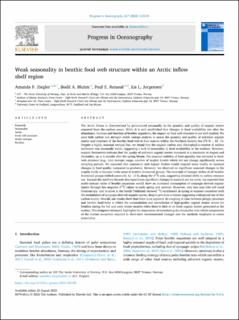| dc.description.abstract | The Arctic Ocean is characterized by pronounced seasonality in the quantity and quality of organic matter exported from the surface ocean. While it is well established that changes in food availability can alter the abundance, biomass and function of benthic organisms, the impact on food web structure is not well studied. We used bulk carbon and nitrogen stable isotope analysis to assess the quantity and quality of sediment organic matter and structure of the benthic food web in four seasons within the Northern Barents Sea (76°N − 82 °C). Despite a highly seasonal vertical flux, we found that the organic carbon and chlorophyll-a content of surface sediments was seasonally stable, suggesting a lack of seasonality in food availability at the seafloor. However, organic biomarkers indicate that the quality of sediment organic matter increased to a maximum in August and December, up to 6 months after the spring bloom. The seasonal stability of food quantity was mirrored in food-web structure (e.g., total isotopic range, number of trophic levels) which did not change significantly across sampling periods. We expected that suspension and deposit feeders would respond more readily to seasonal changes in food quality compared to predators. However, we observed no significant seasonal changes in the trophic levels or isotopic niche areas of benthic functional groups. The centroids of isotopic niches of all benthic functional groups shifted seasonally by <2 ‰ along the δ13C-axis, suggesting minimal shifts in carbon resource use. Because the northern Barents Sea experiences significant changes in seasonal sea ice cover, we expected that stable-isotope ratios of benthic organisms would show an increased consumption of sympagic-derived organic matter through less negative δ13C values in early spring and summer. However, only two taxa (the soft coral Gersemia spp. and bivalves in the family Yoldiidae) showed 13C-enrichment in spring or summer consistent with the assimilation of sympagic-derived organic matter, despite previous evidence suggesting widespread use of this carbon source. Overall, our results show that there is an apparent de-coupling in time between pelagic processes and benthic food-webs in which the accumulation and assimilation of high-quality organic matter occurs for benthos during the fall and early winter months when there is little to no fresh organic matter generated at the surface. This temporal mismatch highlights the importance of considering the timescales over which components of the marine ecosystem respond to short-term environmental changes and the methods employed to assess seasonality. | |
